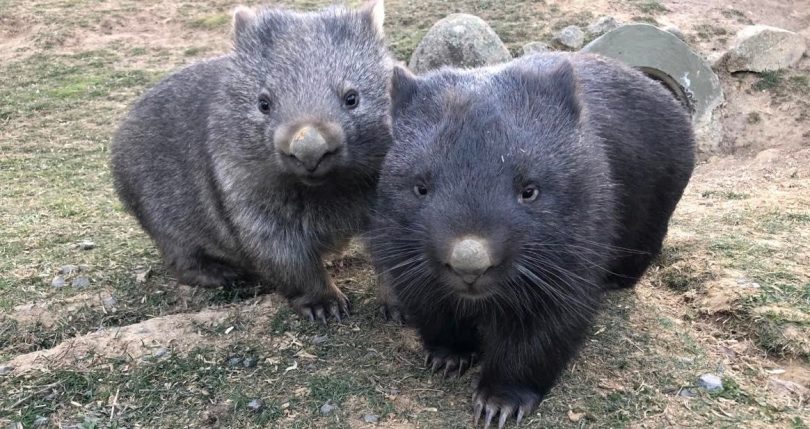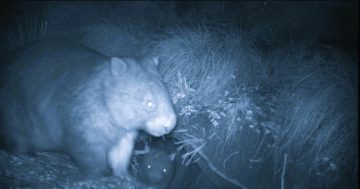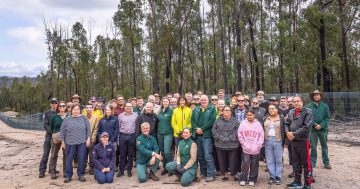
The nocturnal bare-nosed wombat was once widespread but today, has discontinued and fragmented distribution. Image: Dr Hayley Stannard.
Wombat roadkill can be a distressing sight, but a project to markedly reduce wombat deaths is underway in the Snowy Mountains region.
The project involved a study exploring the use of “virtual fences” to conserve wombat populations and minimise road accidents, which took place along Old Bega Road near Glenbog State Forest, west of Bemboka.
Charles Sturt University researcher Dr Hayley Stannard led the study in collaboration with local wildlife carers, Snowy Monaro Regional Council and researchers from Western Sydney University.
There are hopes citizen science can also help the greater cause.
Dr Stannard – a lecturer in veterinary and animal physiology at CSU’s School of Agricultural, Environmental and Veterinary Sciences in Wagga Wagga – said roadkill is a worldwide issue that can cause extinctions.
“In Australia numerous species are affected, however the bare-nosed wombat (Vombatus ursinus) is particularly vulnerable due to its preference for disturbed habitats,” she said.

Ray Wynan and Dr Hayley Stannard doing burrow and vegetation surveys during the two-year study. Photo: Dr Hayley Stannard.
One of the few marsupials active above the snowline in winter, the nocturnal species was significantly widespread at the time of European settlement, but today has a discontinued and fragmented distribution.
Dr Stannard said despite their International Union for Conservation of Nature status being ‘least concern’, bare-nosed wombats have an important role in the ecosystem and are readily impacted by vehicle collisions.
“Collisions with motor vehicles causes significant damage to the vehicle and sometimes the driver and other vehicle occupants, as well as wounding or killing the wombat,” she said.
“Virtual fences are light and sound-based devices, originally developed in Austria, that can be used to reduce roadkill through mitigation,” Dr Stannard said.
In the study, a virtual fence was installed along a 1.5 km stretch of Old Bega Road in semi-rural NSW and the remainder was used as a study control.
Jarake Wildlife Sanctuary wildlife carers Marie and Ray Wynan monitored for roadkill every couple of days.
“The section where we placed the fence was surrounded mostly by farmland (sheep and cattle farms) and a bit of bushland,” Dr Stannard said. “Wombats don’t mind disturbed habitats and had many burrows along the roadside.”
The number of road-killed wombats was counted before and after the fence was installed in March 2020. Prior to the fence being installed, 23 wombats were killed and after, only six wombats were killed.
In comparison, along Old Bega Road outside the fenced area, 64 wombats were killed pre-fence installation and 17 were killed post-fence installation.
Dr Stannard noted that NRMA Insurance claims data showed there were more than 13,000 collisions involving animals in 2019 and rural areas have higher rates of vehicle-animal collisions. On the rare occasion, hitting a wombat can result in human fatality.
“Virtual fencing implemented in regions that have high wombat roadkill rates may aid in reducing road deaths and species conservation,” she said.
She said additional research is required to assess virtual fencing as a roadkill mitigation strategy, including an investigation into a larger number of species in a range of different habitats.
“We do need to do more research to look at how a range of animals actually react to virtual fences,” she said. “Do they react to the lights and sounds and how can these be used effectively? Or do we design something that is more specific to wombats?”
Dr Stannard said research on humans would also assist.
“We need to look at effective strategies to get people to slow down in areas with high wildlife densities near roadsides and possibly build underpasses and overpasses for wildlife too,” she said.
Dr Stannard, who has been doing this research over a COVID-slowed two years said it could be used for other wildlife, such as kangaroos and Tasmanian devils.
“Virtual fence research has been tried with other animals in Australia previously in the west coast of Tasmania and south of Hobart,” she said.
Interested readers can help by accessing the WomSAT webpage and downloading the mobile phone app, which allows citizen scientists to upload sightings of live or dead wombats, scats and burrows.
Resulting data will further knowledge of wombat distribution and sarcoptic mange prevalence and help identify roadkill hotspots, Dr Stannard said.
Viewers can see a virtual fence in action on this YouTube video.









